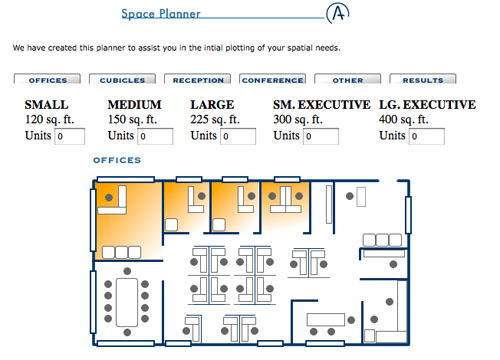So you’ve determined it is time to look into office space for lease. Before you contact a Commercial Broker, there are some questions you may want to look into.
First of all, determine exactly how much space you need.
– Ask yourself what sort of offices you need. Are private offices necessary, or would an open workspace fit your style of business?
– Will you require a conference room? What about a break room?
– Estimating how much space to lease is much simpler than it sounds. In fact, you can even use our office space estimation tool
Take a moment to consider if it will be necessary to purchase new desks, build executive suites, or upgrade technological equipment to outfit your new office space. To soften the blow to your budget, get creative and consider selling your used furniture. Many landlords do offer free rent, so factor your furnishing acquisition costs into the negotiation.
When looking at commercial space for lease, it is paramount to think strategically. Envision your company in five years. How will the new space fit your needs then? If you’re planning to hire a substantial number of new employees, you may want to consider larger office space for lease, then look into subleasing a portion of it.
Now that you have a rough idea of the size and type of office space to lease, it is time to look at recurring costs beyond rent. What about heating? The responsibility of who pays for utilities depends on the type of lease. In a single net lease, the tenant pays a monthly rent and property taxes, while the landlord is responsible for all other building operating expenses. Your broker can give you advice about the advantages and disadvantages of different lease options.
An ideal office suite is nothing if it is not properly maintained. The level of amenities offered by landlords varies with building class. Consider the building’s profile and how this will reflect on your business. When touring commercial real estate for lease, take note of:
– Cleanliness of common areas
– Smudges on elevator shafts
– State of bathrooms
– Presence of maintenance staff
– Security
Employee and client comfort is key, so sit down with your team and discuss these factors and where they fall within your priority list.
Next, it’s time to look at location. Be sure to reference our guides to various Boston area submarkets if you’re unfamiliar with the area. Some location factors to consider include:
– Parking needs
– Public transportation needs
– Restaurants
– For Retail users, determine traffic and visibility, and if these align with your target clients
Rank these in order of importance. Let your broker know if there are factors you’re willing to compromise on.
After you’ve zeroed in on a potential space, it’s time for research. Take note of the building’s current tenants during the tour. Surf LinkedIn and see if you have any connections to current tenants, then touch base and get firsthand information about the landlord. Is the landlord responsive to complaints and concerns? Are there any quirks about the building, such as a printing loom on the fourth floor? What time do the front desk staff leave?
In summary, be sure to take note of your budget, assess your needs, and determine a location. With proper research and the right realtor, finding the perfect office space for lease can be a painless and exciting challenge.

